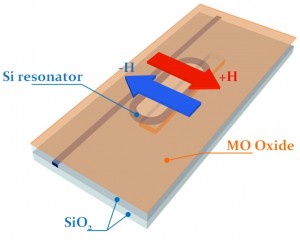Integrated Magnetooptical Isolators
- Category: Optics & Photonics
- Tags: caroline ross, lionel kimerling, mehmet onbasli
We have experimentally demonstrated a monolithically integrated ultra-compact optical isolator on silicon. This device allows a significant device footprint reduction from the centimeter or millimeter scale down to the 10s-of-micrometers level. As a first experimentally demonstrated monolithic nonreciprocal optical component on silicon, this device can also be developed into a variety of integrated nonreciprocal photonic devices including optical circulators, modulators, or switches, which opens a new dimension of functionality for silicon photonics.
The optical isolator, as shown in Figure 1, has been fabricated on silicon on insulator (SOI) substrate with part of the SiO2 top cladding layer etched away to expose the underlying silicon waveguide. Then a magneto-optical oxide thin film layer was deposited to fill this etched region. When an in-plane magnetic field is applied perpendicular to the light propagation direction in the exposed resonator region shown in the figure, a nonreciprocal magneto-optical phase shift is observed for TM polarized light in the resonator. The effective indices between forward and backward propagating TM mode lights are different, and the resonance wavelengths are non-degenerate. This effect is demonstrated in a sketch of the transmission spectra of forward and backward propagating TM polarized light near resonant wavelengths, shown in Figure 2 (a). The different resonant wavelengths allow different transparencies of the device at the given wavelength range, enabling the device to operate as an optical isolator. Experimental demonstration of the device performance was carried out by using an Y3Fe5O12 buffered Ce1Y2Fe5O12 polycrystalline thin film as the magneto-optical oxide layer, fabricated by pulsed laser deposition [1] . The experimental and theoretical TM mode transmission spectra with oppositely applied magnetic fields near the resonance wavelength of 1549.5 nm are shown in Figure 2 (a). This device achieved an isolation ratio of 19.5±2.9 dB, an insertion loss of 18.8±1.1 dB, and a 10 dB isolation bandwidth of 1.6 GHz. We are now investigating multiple resonator configurations for enhanced optical isolation and tunable bandwidth that arises due to the coupling regime, as shown in Figure 2 (b). Tunability range is 100 nm in wavelength [2] .
- Figure 1: Schematic plot of an optical resonator based optical isolator on SOI.
- Figure 2 (a) Experimental and simulation results of the transmission spectrum of a nonreciprocal resonator in Figure 1. (b) Simulated transmission spectrum near tunable resonance, as a function of magneto-optical coupling.
- L. Bi, J. Hu, P. Jiang, D. H. Kim, G. F. Dionne, L. C. Kimerling, and C. A. Ross, “On-chip optical isolation in monolithically integrated non-reciprocal optical resonators,” Nature Photonics, vol. 5, p. 758, 2011. [↩]
- M. Onbasli, J. Hu, L. Bi, G. F. Dionne, and C. A. Ross, “Cascaded magneto-optical ring resonator structures for tunable faraday rotation and reduced isolator footprint,” presented at American Physical Society Meeting, Boston, MA, 2012. [↩]

